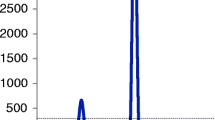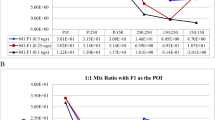Abstract
The broad topic of this paper is the evaluation of DNA evidence in criminal cases. More specifically, we deal with mixture evidence which refers to cases where there are, or could be, several contributors to a biological stain based on, e.g., blood or semen. The present paper adresses DNA mixtures based on single nucleotide polymorphism (SNP) markers, i.e., diallelic markers. Based on STR analysis, it is in most cases easy to identify the presence of a mixture since three or four bands will show up with a high probability for at least one locus. Obviously, this will not be the case for diallelic markers and interpreting mixtures will be a great challenge. We address this problem by first approaching the more general problem of estimating the number of contributors to a stain. In addition we discuss how the markers should be selected and how many are required.


Similar content being viewed by others
References
Brenner C, Fimmers R, Baur M (1996) Likelihood ratios for mixed stains when the number of donors cannot be agreed. Int J Legal Med 109:218–219
Buckleton J, Evett IW, Weir BS (1998) Setting bounds for the likelihood ratio when multiple hypotheses are postulated. Sci Justice 38:23–26
Curran JM, Triggs CM, Buckleton J, Weir BS (1999) Interpreting DNA mixtures in structured populations. J Forensic Sci 44:987–995
Evett IW, Weir BS (1998) Interpreting DNA evidence. Sinauer, Sunderland MA
Evett IW, Buffery C, Willott G, Stoney D (1991) A guide to interpreting single locus profiles of DNA mixtures in forensic cases. J Forensic Sci Soc 31:41–47
Evett IW, Gill P, Lambert J (1998) Taking account of peak areas when interpreting mixed DNA profiles. J Forensic Sci 43:62–69
Fukshansky N, Bär W (1998) Interpreting forensic DNA evidence on the basis of hypothesis testing. Int J Legal Med 111:62–66
Fung WK, Hu YQ (2000) Interpreting forensic DNA mixtures: allowing for uncertainty in population substructure and dependence. J R Statist Soc A 163:241–254
Fung WK, Hu YQ (2002) The statistical evaluation of DNA mixtures with contributors from different ethnic groups. Int J Legal Med 116:79–86
Gill P (2001) An assessment of the utility of single nucleotide polymorphisms (SNPs) for forensic purposes. Int J Legal Med 114:204–210
Hu YQ, Fung WK (2003) Interpreting DNA mixtures with the presence of relatives. Int J Legal Med 117:39–45
Lauritzen SL, Mortera J (2002) Bounding the number of contributors to mixed DNA stains. Forensic Sci Int 130:125–126
Mortera J, Dawid AP, Lauritzen SL (2003) Probabilistic expert systems for DNA mixture profiling. Theor Popul Biol 63:191–205
Stockmarr A (2000) The choice of hypotheses in the evaluation of DNA profile evidence. In: Gastwirth JL (ed) Statistical science in the courtroom. Springer, Berlin Heidelberg New York, pp 143–160
Weir BS (1995) DNA statistics in the Simpson matter. Nat Genet 11:366–368
Weir BS, Triggs C, Starling L, Stowell L, Walsh K, Buckleton J (1997) Interpreting DNA mixtures. J Forensic Sci 47:213–222
Acknowledgements
This work was supported by the Leverhulme Trust.
Author information
Authors and Affiliations
Corresponding author
Appendix
Appendix
Consider the likelihood L(x) given in Eq. 3. Observe that the likelihood increases in x if all z i =2 and decreases in x if all z i <2. Assume that not all z i equals 2. Then we show below that L(x) always has a single maximum for some x≥1.
Maximizing L(x) is equivalent to maximizing
where C<0 and
We see by direct computation that \({g^{{''}}_{i} {\left( x \right)} < 0}\) for all x>0. Defining h i (x)=log(g i (x)), it follows that \({h^{{''}}_{i} {\left( x \right)} < 0}\) for all x>0, and thus that f(x)<0 for all x>0. Further, we get that lim x→∞ g i (x)=1, that lim x→∞ h i (x)=0, and that lim x→∞ f(x)=–∞. These two facts about f show together that f, and thus L, has a unique maximum for some x≥0. For discrete x, one or two consecutive positive integers maximize L.
Rights and permissions
About this article
Cite this article
Egeland, T., Dalen, I. & Mostad, P.F. Estimating the number of contributors to a DNA profile. Int J Legal Med 117, 271–275 (2003). https://doi.org/10.1007/s00414-003-0382-7
Received:
Accepted:
Published:
Issue Date:
DOI: https://doi.org/10.1007/s00414-003-0382-7




